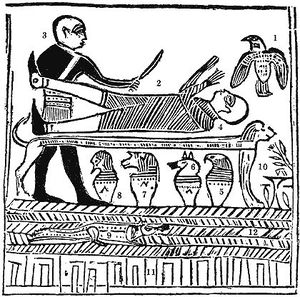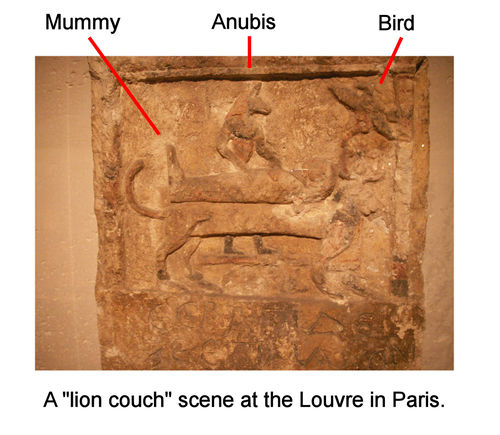Índice
Book of Abraham Facsimile 1: The "lion couch" scene
NEEDS TRANSLATION

Facsimile 1 from the Book of Abraham
Perguntas
The following claims are made regarding Facsimile 1:
- That facsimile 1 is simply a typical funerary scene and there are many other papyri showing the same basic scene.
- It is claimed that the missing portions of the drawing were incorrectly restored:
- The head of the priest should have been that of Anubis.
- The priest should not have been holding a knife.
- The portion portrayed as Abraham's second hand should have been the wing of a second bird.
- It is claimed that Abraham has never been associated with the lion couch vignette such as that portrayed in Facsimile #1 of the Book of Abraham.
A Igreja de Jesus Cristo dos Santos dos Últimos Dias responde a estas questões (Inglês)
Joseph Smith’s explanations of the facsimiles of the book of Abraham contain additional earmarks of the ancient world. Facsimile 1 and Abra. 1:17 mention the idolatrous god Elkenah. This deity is not mentioned in the Bible, yet modern scholars have identified it as being among the gods worshipped by ancient Mesopotamians. Joseph Smith represented the four figures in figure 6 of facsimile 2 as “this earth in its four quarters.” A similar interpretation has been argued by scholars who study identical figures in other ancient Egyptian texts. Facsimile 1 contains a crocodile deity swimming in what Joseph Smith called “the firmament over our heads.” This interpretation makes sense in light of scholarship that identifies Egyptian conceptions of heaven with “a heavenly ocean.”
(
Clique aqui para obter o artigo completo (Inglês))
Perguntas e respostas detalhadas
What does the lion couch scene normally represent?

Photograph of Facsimile 1 from the recovered Joseph Smith Papyri
The papyrus with the illustration represented in Facsimile 1 (view) is the only recovered item that has any connection to the text of the Book of Abraham.
This vignette is called a "lion couch scene" by Egyptologists. It usually represents the embalming of the deceased individual in preparation for burial. However, this particular lion couch scene represents the resurrection of Hor (figure 2), aided by the Egyptian god Anubis (3).[1]
Abra. 1:12 and the notes to Facsimile 1 identify it as representing Abraham being sacrificed by the priest of Elkenah in Ur.
Is Joseph Smith papyri Facsimile 1 common and similar to other such scenes?
Although many similar lion couch scenes exist, this one has quite a few unique features:
- No other lion couch scene shows the figure on the couch (Osiris) with both hands raised. (There is a dispute regarding whether or not two hands are represented. See below)
- No other lion couch scenes show the figure lying on the couch clothed in the manner shown in Facsimile 1. In most other lion couch scenes, the reclining figure is either completely nude or fully wrapped like a mummy. There is one known scene in which the figure is wearing a loin cloth. None to date show the type of clothing being worn by the figure in Facsimile 1.
- No other lion couch scenes to date have shown the reclining figure wearing anklets or foot coverings.
- No other lion couch scenes show a crocodile beneath the couch.
- The original of Facsimile 1 shows the couch behind the priest's legs, and the reclining figure's legs are shown in front of the priest's. The figure was transferred on to the woodcut prior to publication in the Times and Seasons. The wood cut attempted to correct this odd perspective by placing the legs of the priest behind the lion couch.
- No other such scenes have hatched lines such as those designated as "Expanse" or "Firmament" in Facsimile 1.
- No other such scenes are known to have the twelve gates or pillars of heaven or anything like them.
- No other such scenes show a lotus and an offering table. These items are common in other Egyptian scenes, but do not appear in the lion couch scene.
Therefore, we do not agree that it is the "same funeral scene." Facsimile 1 actually depicts the resurrection of Osiris. The figure on the couch is alive. The figures to which it is compared all show the preparation of a mummy.

Photograph of "lion couch" carving displayed at the Louvre in Paris. Note that there is only a single bird shown. (click to enlarge)
Para mais informações relacionadas a este tópico
Resumo: With relation to the claim that a missing portion of Facsimile 1 contained a second bird, the partial figure interpreted as Abraham's second hand is claimed to actually be a portion of the wing of this bird. It is claimed by some that this scene should contain two birds. However, not all lion couch images contain two birds.
Resumo: Joseph interpreted this figure to be "The idolatrous priest of Elkenah attempting to offer up Abraham as a sacrifice." This figure is normally represented in lion couch scenes as having the jackal head of Anubis. If the portion of the priests head was indeed missing at the time that the facsimile was copied prior to its publication in the Times and Seasons, it may have been restored simply by copying the head of the figure lying on the lion couch. Unlike standards that would be following in publishing today, it was not considered acceptable at that time to publish a figure with missing gaps. Joseph correctly interpreted the figure as a priest. Whether the priest has a human head or is wearing the mask of Anubis makes no difference to the interpretation.
Resumo: Alega-se que Abraão nunca estaria associada com a cena egípcia "leão sofá".
Notas
- ↑ Michael D. Rhodes, The Hor Book of Breathings: A Translation and Commentary (Provo, Utah: FARMS, 2002), 19 (18–23).

